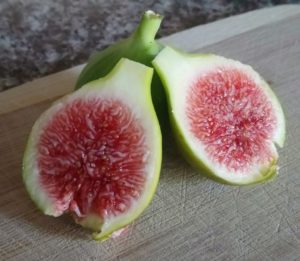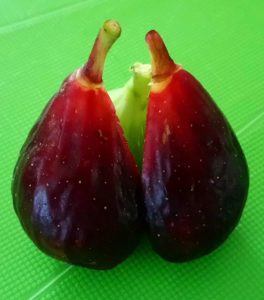Mid-summer fruit culture is celebrated with a bounty of figs. All of the fruit from varieties in our demonstration orchard in Angleton are beginning to mature and harvest will be coming soon. We currently host eight different varieties, some standards like Brown Turkey (also known by the name Texas Everbearing), Mission, Magnolia and Celeste, others offering unique fruit color and texture like LSU Purple, Italian Black, Alma and a mystery green fruiting fig called Mysteak. Even though each fruit variety is slightly different, I wish to impart information about their culture that may assist you in your pursuit of fig happiness.
With a little preparation and planning figs can be grown quite successfully in the home landscape. Figs are adaptable to soil type, especially soils with higher salt content and are a good fruit tree for home landscapes located close to the coast. The trees should be planted in well-drained soil and spaced 15-feet apart from any other tree or landscape feature. They can get quite large at 20-feet tall and wide, and are often grown as a spreading, multi-trunk specimen. If your tree is newly planted or less than three years old, I encourage you to prune your tree to a single trunk specimen and control lateral growth and height to a manageable harvesting stature. Fig trees have fibrous, shallow root systems and must be protected from water loss, winter temperature fluctuation and soil compaction with an adequate mulch layer. Remember that fig trees are generally not cold tolerant, limited to regions with mild winters well above minimum 10-degree temperatures and mulching is a good practice to minimize weed growth and aid in keeping the orchard floor clean. Most varieties produce once a year in mid to late summer on new annual growth and are often pruned in late winter, and a few like Celeste and Alma have two crops, producing additionally in spring from previous year’s wood and referred to as a breba crop. Varieties with a breba crop should be pruned less vigorously to induce spring fruiting.
One question that pops up every year is how to keep varmints out of the orchard. Squirrels and birds notoriously use the fruit of our labor for sustenance, and baffles placed around the trunk to exclude squirrels is impractical with a multi-trunk tree. If practical and directly related to your pruning regime, you can try a temporary shroud of fine mesh netting to exclude these critters. Another potential that will take a bit of time and is used in small orchard peach production are fruit bags, gauze or thin paper bags that are lovingly wrapped around individual fruits. Clemson Cooperative Extension offers a version for sale, or you can search online for alternative companies. One resource recommended constructing your own out of small gift bags made of organza fabric. Let you imagination lead you on this effort. Eating figs is more pleasurable than picking them, and summer harvest is early work in the day to avoid heat stress. Protective gear like gloves and long sleeves should be worn to lessen contact dermatitis from the fine, short and coarse hair-like bristles on the leaves, and possibly eye wear to avoid exposure to fig latex, a milky, mildly toxic sap expressed from cut branches and fruit stems. Fruit production may begin when an established tree reaches two years old. Figs must be harvested when ripe and will not continue to ripen once picked, prompting preservation via canning or drying with a bountiful harvest.
Figs are truly a part of our coastal culinary culture, a fruit high in natural sugars, minerals and soluble fiber. Information about fruits and vegetables support the Texas A&M AgriLife Extension Service initiative Path to Plate, a research-based education program that helps consumers understand how food choices impact their health. Browse to our Brazoria County AgriLife Horticulture website for info about upcoming programs: https://brazoria.agrilife.org/horticulture/, you can always email me directly with any gardening questions at: sbrueggerhoff@tamu.edu, and I look forward to seeing you in the garden.


